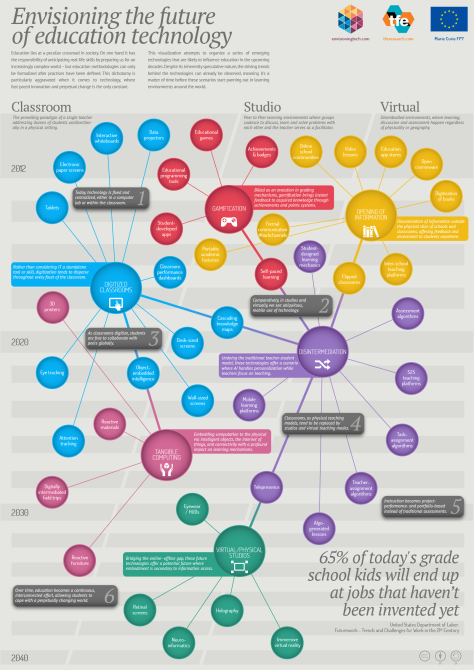It wouldn’t be right to end off my blog if I didn’t post another infographic (as you can tell, I like them!!) This one sums up the present and future trends and technology in the classroom. I wonder if the classroom will really be completely digital in 2020 and with retinal recognition to log on in 2030..who knows what the future holds in this ever changing world we live in?
Tag Archives: education
Technology and Trends In Education
We were asked to research two articles and one Web 2.0 tool that reflect the use of social media used in education today. Here are my findings:
Article #1- Study Suggests Benefits of Social Media in the Classroom
A theory on the rise in education is that students learn best when they interact with others in small groups. This theory is called the social learning theory or social cognitive theory. Studies suggest that a students success in education is the ability to work in small groups. Students who study once a week were shown to be more focused, and retained more information than those who worked independently.
From the Harvard School of education, Dr. Richard Light says it is more important for students to work/participate in small groups compared to the instructor’s teaching style. He also suggests that social media gives the students opportunities to increase their learning by using the various platforms (i.e., Twitter, Facebook, Edmodo, Saywire). These allow the classroom to form a “community” where they can communicate and collaborate their ideas. Group learning is supportive of the thought that many minds are better than one and this way of learning is “cool” with the younger generation. Dr. Light’s studies suggest that the increased use of social media by students is partly due to the increase use of online learning tools in schools via blogs, wikis and podcasts.
The use of social media should be specific to course content, regulated and the instructors should be trained in such tools for teaching. The use of social media in the classroom should help in the learning process and not have a negative impact. Having said that, it is also recommended that the schools using social media sites should update their Acceptable Use Policy to protect the teachers, students and schools involved.
Article #2 – Adult Education and the Social Media Revolution
Distance education is on the rise as adult learners are living longer and workplaces require continual education in order to be successful. Adult learners are self-directing in their learning process, whereby they like to be active in selecting content, social mediums to work with and ultimately apply the knowledge to the real world. Some issues with using social media in adult education are that the learners may be reluctant to use new modes of learning as they like the old tried and true methods, they may lack the skills required to use the technology or may simply not have access to it.
Social media is recommended for teaching solely online, blended courses (some material online and some in class) or personally in the classroom. The technology allows the students and teachers to work in a ” cooperative and collaborative” (LeNoue, p 5) environment. Having such a vast array of methods to choose from allows the instructors to create options for the students to work from, thus giving the students the control over their assignments and learning. Using a social medium tool allows a greater number of participants to take part, while creating an independent environment that is self-paced.
As we transform into the next generation of instruction, the technology allows customization for instruction and delivery of education, allowing for independence of the students taking charge of their work and owning it. The “net generation” (LeNoue, p 6) is forcing teachers to change their approach and to focus on student learning via collaboration. “Transformation and lifelong learning are core ideals of the practice of adult education” (LeNoue, p 9).
Web 2.0 Tool – Edmodo
Edmodo is a free, secure social networking site for teachers and students. The idea to create this site came about in 2008 when the founder Jeff O’Hara (who works in IT department for a school district) was constantly asked to block video and social media sites. He, along with co-founder Nic Borg, created this platform that is driven by the teaching community and is constantly updated with teachers thoughts and suggestions. Currently it has over 12.5 million teachers and students globally connected .
Teachers and students can post messages,discuss topics, post grades, share links, photos, videos, documents and presentations. The layout and function is very similar to Facebook, so the students find it easy to get around the site. With todays technologies, this site can be accessed anytime and anywhere. The site allows teachers to connect with other teachers and resources. The students can send private messages to the instructor or the group but not to each other. This allows the teacher to control the postings and decreases the chance of bullying online. A possible disadvantage for this platform is that the students may not have a computer or the internet at home. Teachers need to set out clear guidelines in respect to the rules, expectations and purpose of using such a tool to avoid becoming a social chat room.
As the site is only four years young, I can only imagine how it will evolve as time goes on. We could collectively create a great teaching tool by having more people use this site and give feedback to the founders. Isn’t that what this course is about…collaboration, technology, teaching and the future!
References
LeNoue, M., Hall, T., & Eighmy, M.A. (2011). Adult Education and the Social Media Revolution. Adult Learning, 22(2), 4-12. Retrieved from Academic Search Premier, EBSCO host on October 12, 2012.
Tomaszewski, J. (2012). Study suggests Benefits of Social Media in the Classroom. Retrieved from http://www.educationworld.com/a_curr/study-suggests-social-media-has-place-in-classrooms.shtml on October 7,2012.

